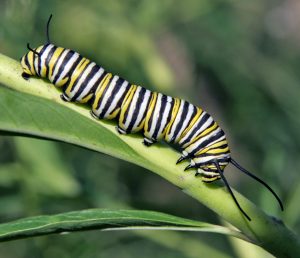 Monarch butterfly (Danaus plexippus) caterpillars are probably the one insect most people associate with milkweeds (Asclepias spp.). But if you’ve ever grown or just observed milkweeds, likely you’ve encountered some other insects on those plants. Not many insects are able to feed on milkweeds. The sticky white sap that gives milkweed its common name and the leaves contain toxic chemicals (cardiac glycosides) to deter mammals and insects from feeding on the foliage. Only certain insects which have evolved to be able to deal with those chemicals without being poisoned can thrive on the plants, and have become specialists on milkweeds.
Monarch butterfly (Danaus plexippus) caterpillars are probably the one insect most people associate with milkweeds (Asclepias spp.). But if you’ve ever grown or just observed milkweeds, likely you’ve encountered some other insects on those plants. Not many insects are able to feed on milkweeds. The sticky white sap that gives milkweed its common name and the leaves contain toxic chemicals (cardiac glycosides) to deter mammals and insects from feeding on the foliage. Only certain insects which have evolved to be able to deal with those chemicals without being poisoned can thrive on the plants, and have become specialists on milkweeds.

The flowers and nectar of milkweeds, however, do not contain these chemicals so nectar-seeking bees, flies, and butterflies can pollinate the plants without being affected.
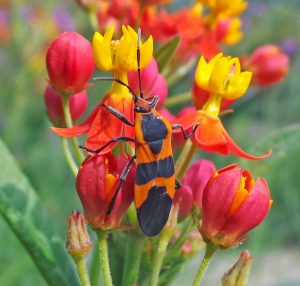
And just like the monarch caterpillars which sequester and concentrate the toxins in their own bodies, giving them a bitter taste and protection against predators, many other milkweed insects – including milkweed bugs, milkweed longhorn beetles, and milkweed leaf beetles – have developed ways for using the toxins in their own defense, too. The insects that have this ability typically have aposematic markings, or warning coloration, advertising their toxicity. This is why so many insects found on milkweed plants have conspicuous red or orange colors or markings. A few other milkweed specialists have developed ways to “eat around” the sap to avoid its toxic effects.
Another caterpillar that specializes on milkweeds is the milkweed tussock caterpillar or milkweed tiger moth, Euchaetes egle, in the family Erebidae, subfamily Arctiinae (formerly family Acrtiidae). Found throughout eastern North America, this moth with a wing span up to 1¾ inches, has dull grey, mostly unmarked wings and a hairy yellow-orange abdomen marked with black dots. The female moth lays fuzzy white masses of eggs on the underside of the leaves.

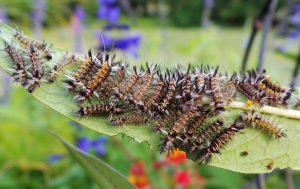
The gregarious early instars skeletonize whole leaves, feeding only on the tissues between the veins, thereby avoiding the copious latex sap. Initially the caterpillars with black head capsules are pale and hairless, and second instar caterpillars have sparse spines or hairs. By the third instar the caterpillars have thick tufts of black, white and orange (sometimes yellow) hairs covering the body. These larger caterpillars wander about so they may be seen alone or in small groups from mid to late summer on common milkweed (A. syriaca) and a few other plants. The older caterpillars sever major leaf veins to reduce the amount of latex sap encountered. Milkweed tussock caterpillar is seldom in competition with monarch caterpillars, as they generally feed on older shoots while monarchs prefer younger shoots. The mature larvae drop to the ground and produce a gray cocoon, incorporating hairs from the caterpillar, where they pupate to become adults or overwinter. This species has a single generation per year in the north (two or more in the south).

Like the monarch caterpillar, this species also sequesters cardiac glycosides and retains them in the adult body. Since the primary predators of the moths are bats, which hunt at night using sound rather than sight to locate prey, the moths don’t need warning coloration. Instead the moth evolved to produce ultrasonic clicks from their tymbal organs which bats quickly learn is associated with a noxious mouthful and then avoid the moth as prey.
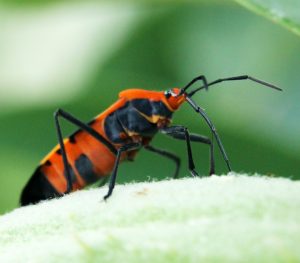
There are two true bugs (family Lygaeidae, order Hemiptera) that are associated with milkweed mostly in late summer and fall, the large milkweed bug and the small milkweed bug. Both are gregarious, feeding exclusively on the sap and seeds of plants in the milkweed family and both have the aposematic colors of red and black. Although they will feed on young leaves, flowers, and developing pods, their preference is for the seeds, which provide the best growth and reproduction, and large congregations of all stages of the insects together can be seen on milkweed plants. Like all true bugs, they have sucking mouthparts to inject digestive enzymes into the plant tissue and then suck the liquefied plant material through their straw-like beak. Because of the length of their mouthparts they are only able to feed on the outside layers of seeds in each pod, leaving many interior seeds intact for plant reproduction. Females lay light lemon yellow eggs in crevices between the seed pods, depositing up to 30 eggs a day for about a month. The eggs change to a bright orange or red color before the nymphs hatch in a few days. The immatures (nymphs) resemble the adults, although the color pattern changes as they go through the five instars before molting to the adult stage. The nymphs remain together, feeding on the developing seeds, although they will scatter if disturbed. There is a single generation each year in Wisconsin. Both species sequester cardiac glycosides in their bodies so are poisonous to most predators.
Milkweed bugs do little damage to milkweeds so control is generally not required. Removing leaf litter and old stalks in the fall can help eliminate overwintering sites. If populations are very high on plants grown for their seeds, the bugs can be treated with insecticidal soap or synthetic chemicals.
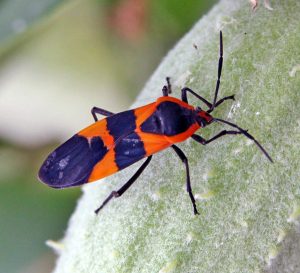
The large milkweed bug, Oncopeltus fasciatus, grows up to ¾ inch long. The adults are orange-red with markings of two black triangles pointing forwards and backwards, separated by a prominent black bar through the middle of the wings. The black pronotum has orange-red margins. Adult males have a black band on the underside of the fourth abdominal segment while females have two black spots on that segment. The adults can be confused with the boxelder bug, but that insect is a little smaller, usually is not found on milkweed, and has a different pattern of black and red. Box elder bugs have three longitudinal red stripes on the pronotum, while the large milkweed bug has a red transverse band, and the boxelder bug has red edges rather than an X-like pattern. The nymphs have an orange body, with black legs, antennae, and wingpads which lengthen with age, and develop small black spots on the abdomen as they mature.

This species occurs from Central America to southern Canada, but does not survive the winter in cold locations like Wisconsin and has to re-invade from the south every year. Northern populations migrate over longer distances than southern and tropical populations, and movements correlate with flowering of milkweeds. The adults migrate south in the fall to overwinter in the southern Atlantic and Gulf coast states, then new generations gradually migrate north again in the spring and summer. In mild climates there can be up to three generations per year, but just a single generation is produced in Wisconsin. This species prefers common milkweed, but will feed on other species of Asclepias, and even other plants in the same family if its preferred food is unavailable.
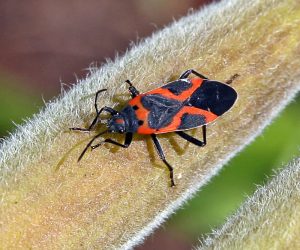
The small milkweed bug, Lygaeus kalmii, only grows up to ½ inch long and are black with a large red X-shape on the back and white margins on the wings and sometimes small white spots in the middle of the wings. There is a red band on the pronotum instead of orange margins as on the large milkweed bug. The nymphs look very similar to large milkweed bug nymphs but are a brighter red and have two diagonal black markings on the pronotum. This species overwinters in Wisconsin as an adult. Although they feed primarily on seeds, adults will sometimes feed on monarch butterfly caterpillars or pupae or other insects trapped in milkweed flowers, or consume nectar from various flowers. This species occurs throughout North America, and is frequently seen on a variety of species of Ascelpias, including swamp milkweed (A. incarnata).
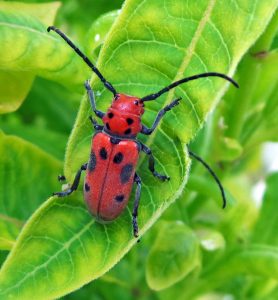
Two beetles (Order Coleoptera) are common on milkweed. The 26 different milkweed longhorn beetles (Tetraopes spp. in the family Cerambycidae) each prefer a different species of milkweed. Of the 13 that occur in the US, only three species occur in the east, and the most common species in Wisconsin is the red milkweed beetle, T. tetraophthalmus.
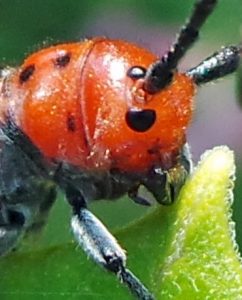
The scientific name tetrophthalmus means “four-eyed” referring to the way each compound eye is completely divided by the base of the antenna. The adult is orange-red with four black spots on the elytra.
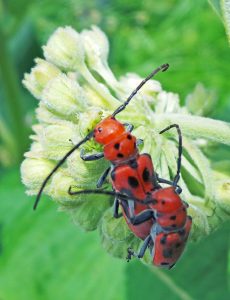
The adults eat milkweed leaves, buds, and flowers, and reduce the flow of the sticky milky latex (which could gum up their mouthparts) by severing leaf veins below their feeding site. The sap drains from the leaf, and the beetle can feed on the drained area beyond the cuts. The females lay their eggs on stems near the ground or just below the surface. The larvae hatch and bore into the stems to travel downward to the roots or go through the soil directly to the roots to feed on the roots through early fall. They overwinter in the roots, pupate in earthen cells in the spring and the adults emerge in early summer, coinciding with hostplant flowering. Common throughout North America from Texas into Canada, it can be very common where its preferred host plant, common milkweed, is present. It can also be found on swamp, whorled or green milkweed.
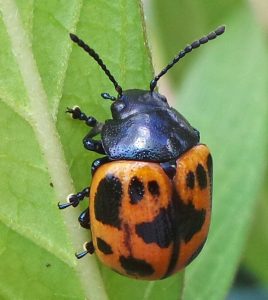
The second beetle is the swamp milkweed leaf beetle, Labidomera clivicollis, a leaf-feeding beetle (family Chrysomelidae) found in eastern North America. Both the brightly colored adults and larvae chew on the foliage of milkweeds, primarily swamp milkweed, although they have been recorded on common milkweed, butterflyweed (A. tuberosa), and a few other plants. The dome-shaped adults are fairly conspicuous with a black head and pronotum, yellow to orange elytra with variable black to dark blue patterning, and metallic blue legs. In early summer female beetles lay up to 300 elongate bright orange eggs in batches of 30-60 on the undersides of the leaves.
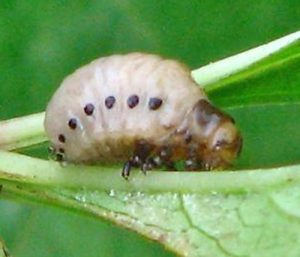
The plump grey to orange larvae with a row of black spots along the side (similar in shape and size to Colorado potato beetle) go through four instars as they eat leaf tissue until late summer. Just like the longhorn beetle, both the larvae and adults of the milkweed leaf beetle cut leaf veins prior to feeding to reduce the sticky latex in their feeding sites. The mature larvae drop to the ground and pupate in the soil. The adults emerge in the fall to feed for a while before overwintering amid debris or in the soil. In the south there can be two generations per year. If populations are too high, the eggs or larvae can be wiped off the plants.
The bright yellow aphids with black legs and cornicles found on milkweed plants are an introduced species, the oleander aphid, Aphis nerii, from the Mediterranean region, where oleander is native. This cosmopolitan pest is now found throughout much of North America, where they use milkweeds and some other ornamental plants in the families Apocynaceae and Asclepiadaceae as hosts. The aphids survive in the southern part of the continent, and every year winged females are blown northward on the prevailing winds in the spring. The parthenogenetic females (producing young without mating) give birth to live, wingless, young females to quickly build up populations. They occur in large clusters on new shoots, stems, buds, and leaves. The aphids continue to produce new, often overlapping generations until resources become limiting and they begin to produce winged forms that can disperse to new plants.

Aphids suck sap from the plant tissues, and if populations are high, can stress plants and kill small or newly planted plants. Heavily infested terminals can be stunted or deformed, and black sooty mold grows on the large amounts of sticky honeydew produced by the aphids. If necessary, aphid colonies can be dislodged with a strong spray of water, or can be treated with insecticidal soap, neem oil, or synthetic insecticides labeled for control of aphids. However, these actions could also affect small monarch caterpillars.

Many natural enemies including lady beetles, syrphid fly larvae, and lacewings feed on aphids and along with parasitoid wasps may provide sufficient control. The parasitoid wasp Lysiphlebus testaceipes lays its eggs singly inside the aphids, where their larvae develop and cause the aphid body to become hard and swollen and a tan or light brown color. A new adult wasp then emerges from the “mummy” that remains stuck on the plant by the embedded mouthparts. These wasps and the common insect predators are not affected by the cardiac glycosides which are sequestered from the milkweed plants by the aphids and are incorporated into the defensive chemicals secreted from the cornicles, but they do deter bird predators.
The related, but less common, pale yellow milkweed aphid, Aphis asclepiadis, occurs on the undersides of milkweed leaves and are generally tended by ants.
– Susan Mahr, University of Wisconsin – Madison
Latest from Wisconsin Yard & Garden
Ask Your Gardening Question
If you’re unable to find the information you need, please submit your gardening question here:





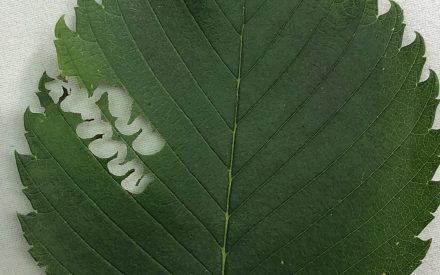 Elm Zigzag Sawfly
Elm Zigzag Sawfly ▶ Watch: How do Pesticides Affect Pollinators and Songbirds in Your Yard
▶ Watch: How do Pesticides Affect Pollinators and Songbirds in Your Yard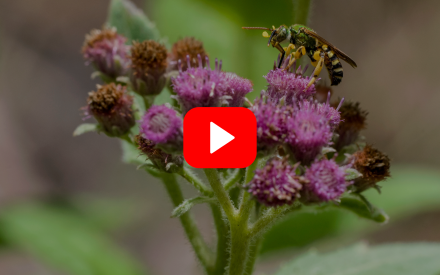 ▶ Watch: Pollinator Gardens: Plant Selection and Garden Care
▶ Watch: Pollinator Gardens: Plant Selection and Garden Care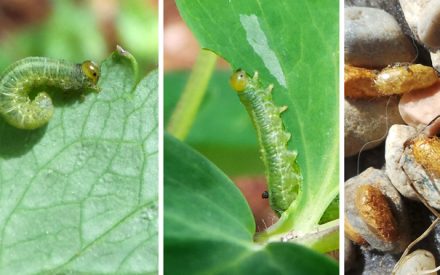 Strategies for Identifying and Managing Insect Pests
Strategies for Identifying and Managing Insect Pests


